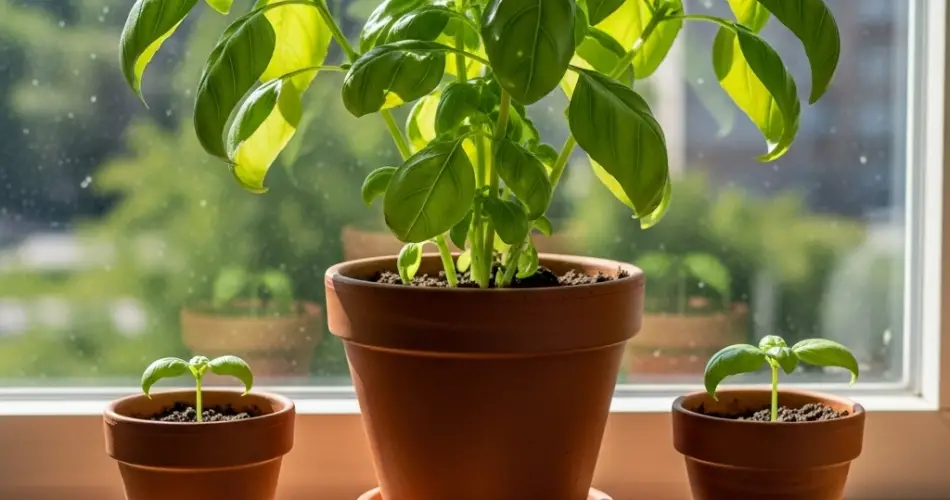Basil is one of the most popular herbs worldwide, renowned for its aromatic leaves that add fresh flavor to countless dishes such as pesto, salads, and pasta. Growing basil in pots is a convenient way to enjoy this herb year-round, whether indoors or outdoors. With proper care, potted basil can thrive on windowsills, balconies, or patios, providing a steady supply of fresh leaves.
This step-by-step guide will help you grow healthy, vibrant basil plants in pots and ensure a bountiful harvest.
Why Grow Basil in Pots?
Growing basil in pots offers several advantages:
-
Space Efficiency: Perfect for small spaces such as apartments or urban gardens.
-
Mobility: Easily move pots to optimize sunlight exposure or protect plants from harsh weather.
-
Control: Manage soil quality, watering, and pest control more effectively than in-ground planting.
-
Accessibility: Keep fresh basil close to your kitchen for easy harvesting.
Choosing the Right Pot and Soil
Select a pot with good drainage holes to prevent waterlogging, which can cause root rot. A container 6 to 12 inches in diameter is ideal for a single basil plant.
Use a high-quality, well-draining potting mix enriched with organic matter. Avoid garden soil, which may compact easily and restrict root growth.
Planting Basil Seeds or Seedlings
You can start basil from seeds or purchase healthy seedlings.
-
From Seeds: Sow basil seeds thinly over moist soil and cover lightly with about 0.5 cm (¼ inch) of soil. Keep the soil consistently moist until germination, which usually takes 5 to 10 days.
-
From Seedlings: Transplant young plants carefully into pots, firming the soil gently around the roots.
Positioning and Light Requirements
Basil thrives in full sun, needing at least 6 to 8 hours of direct sunlight each day.
Place pots on a sunny windowsill, balcony, or outdoor spot with ample light.
If growing indoors with limited sunlight, consider supplementing with a grow light to provide adequate light for healthy growth.
Watering Basil
Maintain consistent moisture but avoid overwatering. Basil prefers soil that is moist but not soggy.
Water when the top inch of soil feels dry to the touch. Water at the base of the plant to keep leaves dry and reduce fungal risk.
Ensure excess water drains freely from the pot.
Feeding and Fertilizing
Feed basil plants every 4 to 6 weeks during the growing season with a balanced, water-soluble fertilizer or an organic alternative like compost tea.
Avoid excessive nitrogen fertilization, which can encourage lush foliage but reduce essential oils and flavor intensity.
Pruning and Harvesting
Regular pruning encourages bushier growth and delays flowering, which can cause leaves to become bitter.
Pinch off the tips of stems regularly once plants reach about 15 cm (6 inches) tall. Remove any flower buds promptly to focus energy on leaf production.
Harvest basil leaves as needed by snipping the outer leaves near the stem base, leaving inner leaves to continue growing.
Preventing Common Problems
-
Leggy Plants: Often caused by insufficient light; increase sunlight exposure or add grow lights.
-
Yellowing Leaves: May indicate overwatering or nutrient deficiency; adjust watering and consider feeding.
-
Pests: Watch for aphids, spider mites, or whiteflies. Remove pests manually or treat with insecticidal soap or neem oil.
-
Fungal Diseases: Ensure good airflow around plants and avoid wetting leaves during watering.
Overwintering Basil
Basil is sensitive to cold and frost. If you live in a cooler climate, bring potted basil indoors before the first frost.
Place plants in a bright, warm spot and reduce watering frequency to avoid root rot during dormancy.
Tips for Success
-
Use pots with drainage and avoid standing water.
-
Rotate pots periodically to promote even growth.
-
Harvest frequently to encourage new leaf growth.
-
Grow different basil varieties for diverse flavors, such as sweet, Thai, or lemon basil.
Benefits of Growing Basil in Pots
-
Freshness: Easily snip fresh leaves anytime.
-
Convenience: Basil close to the kitchen for cooking.
-
Sustainability: Reduces need to buy packaged herbs.
-
Educational: Great for beginners and children learning about gardening.
-
Decorative: Adds greenery and fragrance to indoor or outdoor spaces.
Conclusion
Growing basil in pots is a rewarding and accessible way to enjoy fresh herbs all year round. By choosing the right container, providing sufficient light and water, and practicing regular pruning and care, you can cultivate healthy, flavorful basil plants that enhance your culinary creations.
Whether you’re a novice gardener or an experienced green thumb, pot-grown basil offers convenience, freshness, and beauty in a compact form. Embrace this easy herb gardening method and enjoy the aromatic rewards at your fingertips.



